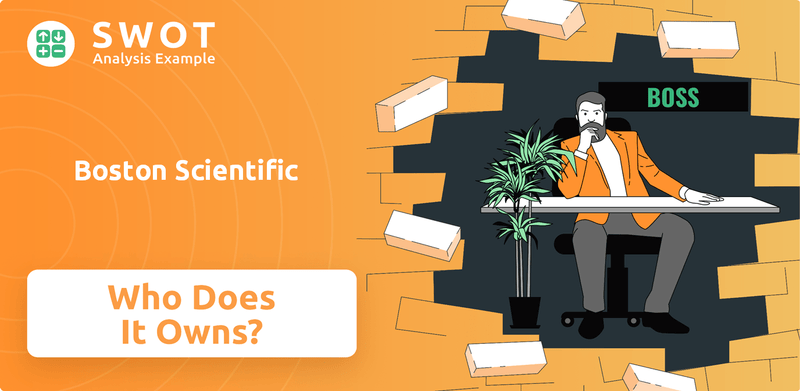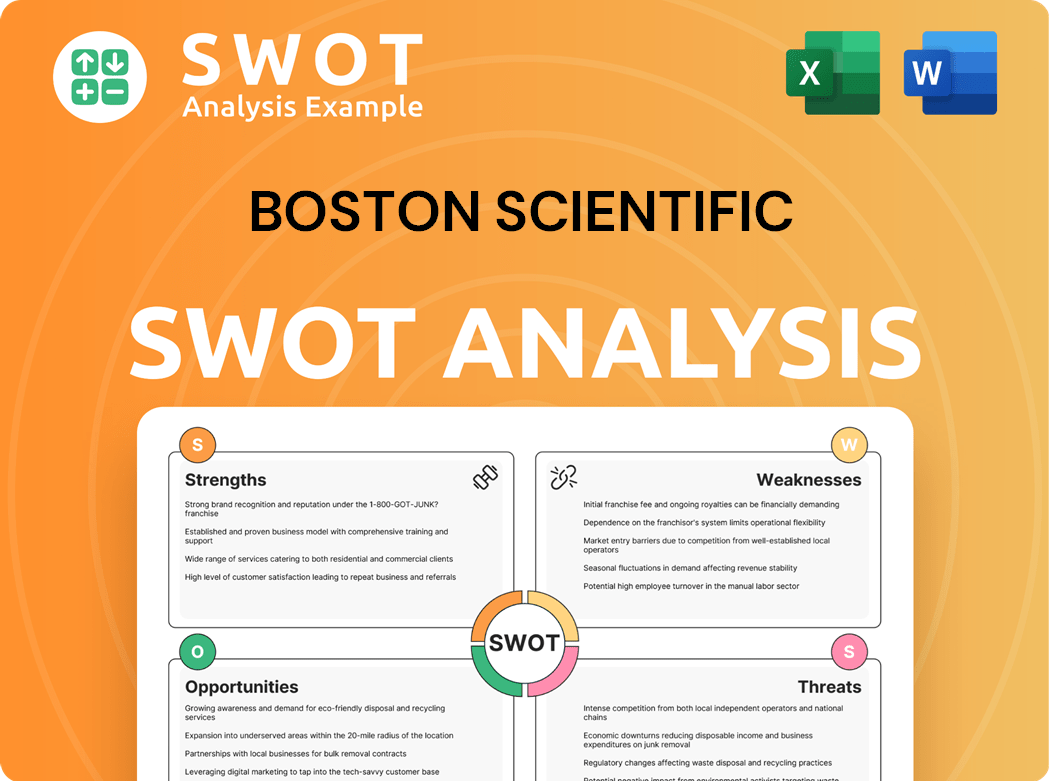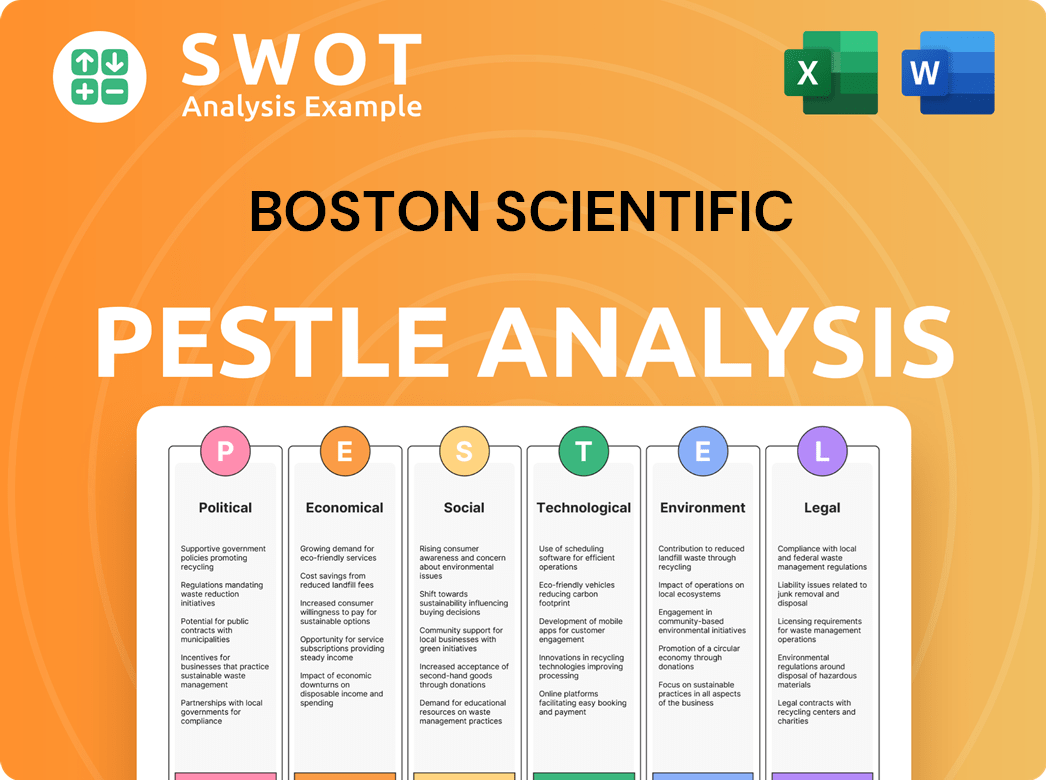Boston Scientific Bundle
Who Really Controls Boston Scientific?
Understanding the Boston Scientific SWOT Analysis is key, but who truly steers this medical device giant? From its humble beginnings in 1979 to its current status as a global leader, Boston Scientific's ownership has evolved dramatically. Knowing the company's major shareholders and their influence is crucial. This article unveils the intricate details of Boston Scientific's ownership structure.

The evolution of Boston Scientific's ownership, from its founders to the current landscape of public and institutional investors, directly impacts its strategic decisions. Exploring "Who owns Boston Scientific" provides critical insights into the company's governance and future direction. Discover the key players and how their stakes shape the company's trajectory, influencing everything from product development to market strategy. Understanding the Boston Scientific ownership structure is essential for anyone analyzing the Boston Scientific stock or interested in the medical device industry.
Who Founded Boston Scientific?
The origins of the company trace back to June 29, 1979, when John Abele and Peter Nicholas joined forces to establish the company. This partnership was built on a shared vision of advancing healthcare through less invasive and more accessible medical solutions. Their collaboration marked the beginning of a journey that would transform the medical device industry.
John Abele, an engineer with a background in philosophy and physics, and Peter Nicholas, a venture capitalist and former pharmaceutical executive, brought complementary skills to the table. They met through their children's soccer game and decided to collaborate. This partnership was pivotal in shaping the company's early direction and its focus on innovation.
The company was initially formed to acquire Medi-Tech, Inc., a pioneer in steerable catheters. Abele and Nicholas secured $500,000 in bank financing and raised an additional $300,000 for this acquisition. This strategic move set the stage for the company's entry into the interventional medicine market.
Abele and Nicholas aimed to improve public health by offering more accessible and less traumatic medical options.
The acquisition of Medi-Tech was funded with $800,000, combining bank loans and additional investments.
In its first year, the company reported revenues of approximately $2 million.
Early products included catheters for gallbladder surgery, marking its initial product offerings.
Following the IPO in May 1992, the founders and their families held two-thirds of the company's stock.
Strategic acquisitions like Kimray Medical Associates in the 1980s expanded its presence in cardiology.
Understanding the early ownership structure provides crucial context for the company's growth and strategic direction. The co-founders' significant stake post-IPO highlights their enduring influence. The company's history is marked by strategic acquisitions that expanded its product offerings and market reach. For more insights, consider reading about the company's history.
- The founders, John Abele and Peter Nicholas, played a pivotal role in shaping the company's initial strategy.
- Early acquisitions, such as Kimray Medical Associates and Endo-Tech, were instrumental in expanding its product portfolio.
- Following the IPO in May 1992, the founders and their families collectively owned a significant portion of the company's stock.
- The company's initial focus was on providing more accessible and less invasive medical options.
Boston Scientific SWOT Analysis
- Complete SWOT Breakdown
- Fully Customizable
- Editable in Excel & Word
- Professional Formatting
- Investor-Ready Format

How Has Boston Scientific’s Ownership Changed Over Time?
The ownership structure of the Boston Scientific company has evolved considerably since its inception. A pivotal moment was the initial public offering (IPO) on May 19, 1992. The IPO offered 23.5 million shares, with 18.8 million in the U.S. and 4.7 million internationally, representing 23% of its outstanding stock. This strategic move enabled the company to secure capital and facilitate its operational expansion.
Currently, Boston Scientific operates as a publicly traded entity on the New York Stock Exchange under the ticker symbol BSX. The ownership is primarily distributed among institutional investors and individual shareholders. As of May 2025, institutional investors hold a substantial portion of Boston Scientific's shares, with institutional ownership remaining unchanged at 92.49%. Mutual funds holding also remained unchanged at 71.74% in May 2025.
| Major Shareholders | Ownership Type | Approximate Stake |
|---|---|---|
| BlackRock, Inc. | Institutional Investor | Significant |
| Vanguard Group Inc | Institutional Investor | Significant |
| Fmr Llc | Institutional Investor | Significant |
| State Street Corp | Institutional Investor | Significant |
| Wellington Management Group Llp | Institutional Investor | Significant |
| Fidelity Investments | Institutional Investor | Significant |
Boston Scientific's growth strategy has also involved strategic acquisitions, which have reshaped its portfolio and market presence. Notable acquisitions include Guidant Corporation in 2006, which bolstered its cardiovascular market presence, and Axonics, Inc. in November 2024, which enhanced its urology portfolio. In March 2025, the company acquired a 90% stake in SoniVie for $360 million. These acquisitions, combined with organic growth, have contributed to robust financial performance, with net sales reaching $16.747 billion for the full year 2024. For more insights into the company's growth, explore the Growth Strategy of Boston Scientific.
Boston Scientific ownership is primarily held by institutional investors. The company's IPO in 1992 was a pivotal moment in its ownership evolution. Strategic acquisitions have significantly shaped the company's market presence and financial performance.
- Institutional investors play a crucial role in the company's strategic decisions.
- The company's stock is traded on the New York Stock Exchange under the ticker symbol BSX.
- Recent acquisitions, such as Axonics, Inc., have expanded its portfolio.
- Net sales for 2024 reached $16.747 billion.
Boston Scientific PESTLE Analysis
- Covers All 6 PESTLE Categories
- No Research Needed – Save Hours of Work
- Built by Experts, Trusted by Consultants
- Instant Download, Ready to Use
- 100% Editable, Fully Customizable

Who Sits on Boston Scientific’s Board?
The Board of Directors at Boston Scientific oversees the company's strategic direction and governance. The board includes a mix of independent directors and executive leadership. Michael F. Mahoney, the CEO, also serves as Chairman. Other key executives like Daniel Brennan (CFO) and Arthur Butcher are also involved in company presentations and discussions with investors. For detailed information on the board members, their roles, and any changes, one should refer to the company's annual proxy statements.
As of May 2025, Boston Scientific operates with a one-share-one-vote structure. Institutional investors hold a significant portion of the outstanding shares, approximately 92.49%, which gives them substantial voting power. These investors influence key decisions such as board elections and executive compensation. While specific details on dual-class shares or special voting rights are not readily available in public summaries, the dominance of institutional ownership suggests a governance model where large investment firms hold considerable sway.
| Board Member | Title | Shareholding Percentage (approximate) |
|---|---|---|
| Michael F. Mahoney | Chairman and CEO | 0.11% (April-May 2025) |
| Daniel Brennan | CFO | 0.02% (April-May 2025) |
| Other Board Members | Independent Directors | Varies, details in proxy statements |
Recent developments show no major proxy battles or significant challenges to Boston Scientific's board or governance in 2024-2025. The company is focused on innovation and strategic acquisitions. Leadership actively engages with investors to discuss performance and the future outlook. Insider holdings, including those of key executives, represent a small fraction of the total shares, with overall insider holdings decreasing slightly to 0.17% in May 2025. This reinforces the dispersed ownership structure and the influence of institutional capital. To understand more about the company's target market, you can read this article.
Institutional investors hold the majority of shares, influencing key decisions. The CEO also serves as Chairman, providing leadership continuity. Insider ownership is relatively small, highlighting the significance of institutional investors.
- Majority ownership by institutional investors.
- One-share-one-vote structure.
- CEO as Chairman.
- Focus on innovation and acquisitions.
Boston Scientific Business Model Canvas
- Complete 9-Block Business Model Canvas
- Effortlessly Communicate Your Business Strategy
- Investor-Ready BMC Format
- 100% Editable and Customizable
- Clear and Structured Layout

What Recent Changes Have Shaped Boston Scientific’s Ownership Landscape?
Over the past few years, the ownership profile of Boston Scientific has been shaped by strategic acquisitions and a focus on innovation. In 2024, the company experienced a strong performance, driving its market capitalization to approximately $147.56 billion as of June 2025, reflecting a substantial increase of 33.86% in one year. This growth has been fueled by an innovative product portfolio and effective commercial strategies.
Significant mergers and acquisitions (M&A) have played a key role in shaping the company's trajectory. In November 2024, Boston Scientific acquired Axonics, Inc., and in January 2025, Cortex, Inc., was acquired. Additionally, in March 2025, a 90% stake in SoniVie was acquired. These moves are aimed at enhancing its competitive position and addressing unmet clinical needs, with analysts anticipating further M&A activity in 2025. The article Marketing Strategy of Boston Scientific provides more details on the company's approach.
| Ownership Category | As of May 2025 | Change |
|---|---|---|
| Institutional Investors | 92.49% | Unchanged |
| Mutual Funds | 71.74% | Unchanged |
| Insider Holdings (Michael F. Mahoney) | 0.11% | Slight Decrease |
| Insider Holdings (Daniel J. Brennan) | 0.02% | Slight Decrease |
The ownership structure of Boston Scientific indicates a strong presence of institutional investors, remaining steady at 92.49% as of May 2025, and a significant holding by mutual funds at 71.74%. Insider holdings are relatively small, with a slight decrease in overall insider ownership. This suggests a dispersed ownership pattern among a large number of institutional shareholders, rather than concentrated control by founders or insiders.
Boston Scientific's market capitalization reached approximately $147.56 billion as of June 2025, marking a 33.86% increase in one year. This reflects the company's strong performance driven by innovation and strategic acquisitions. The company's financial health is a key factor for investors.
Notable acquisitions include Axonics, Inc., Cortex, Inc., and a majority stake in SoniVie. These moves expand Boston Scientific's product offerings and market reach. These acquisitions are expected to contribute to the company's growth.
Institutional investors hold a dominant position, with 92.49% ownership as of May 2025. Mutual funds also hold a significant stake at 71.74%. Insider ownership is relatively small, indicating dispersed ownership.
The company projects net sales growth of approximately 15% to 17% on a reported basis and 12% to 14% organically for the full year 2025. Adjusted EPS for 2025 is estimated to be in the range of $2.87 to $2.94. The company's future is looking bright.
Boston Scientific Porter's Five Forces Analysis
- Covers All 5 Competitive Forces in Detail
- Structured for Consultants, Students, and Founders
- 100% Editable in Microsoft Word & Excel
- Instant Digital Download – Use Immediately
- Compatible with Mac & PC – Fully Unlocked

Related Blogs
- What are Mission Vision & Core Values of Boston Scientific Company?
- What is Competitive Landscape of Boston Scientific Company?
- What is Growth Strategy and Future Prospects of Boston Scientific Company?
- How Does Boston Scientific Company Work?
- What is Sales and Marketing Strategy of Boston Scientific Company?
- What is Brief History of Boston Scientific Company?
- What is Customer Demographics and Target Market of Boston Scientific Company?
Disclaimer
All information, articles, and product details provided on this website are for general informational and educational purposes only. We do not claim any ownership over, nor do we intend to infringe upon, any trademarks, copyrights, logos, brand names, or other intellectual property mentioned or depicted on this site. Such intellectual property remains the property of its respective owners, and any references here are made solely for identification or informational purposes, without implying any affiliation, endorsement, or partnership.
We make no representations or warranties, express or implied, regarding the accuracy, completeness, or suitability of any content or products presented. Nothing on this website should be construed as legal, tax, investment, financial, medical, or other professional advice. In addition, no part of this site—including articles or product references—constitutes a solicitation, recommendation, endorsement, advertisement, or offer to buy or sell any securities, franchises, or other financial instruments, particularly in jurisdictions where such activity would be unlawful.
All content is of a general nature and may not address the specific circumstances of any individual or entity. It is not a substitute for professional advice or services. Any actions you take based on the information provided here are strictly at your own risk. You accept full responsibility for any decisions or outcomes arising from your use of this website and agree to release us from any liability in connection with your use of, or reliance upon, the content or products found herein.